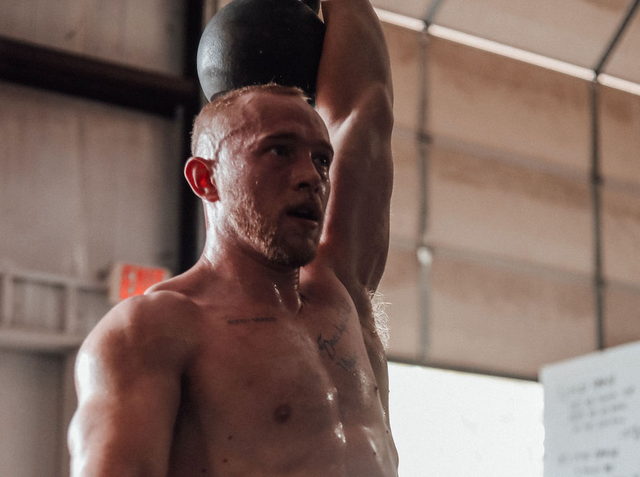If you want to build a bigger, more defined chest—without spending hours in the gym—dumbbell supersets are one of the most effective tools in your training arsenal. Supersets increase time under tension, boost intensity, and create metabolic stress, all of which are critical for hypertrophy.
Dumbbells offer a unique advantage: they force each side of your body to work independently, improving muscle symmetry, engaging stabilizers, and allowing a greater range of motion than barbell pressing. Paired with strategic superset pairings, they can help you maximize chest activation across all angles—upper, middle, and lower.
In this guide, you'll get the best dumbbell superset combinations for chest day, complete with exercise instructions, muscle targeting strategies, and science-backed programming tips.
What Are Supersets?
Supersets involve performing two exercises back-to-back with little to no rest between them. They’re one of the most efficient ways to increase training intensity, volume, and time under tension—all key drivers of hypertrophy and fat loss.
There are a few types of supersets, each with a distinct training purpose:
1. Agonist Supersets (Same Muscle Group)
Both exercises target the same muscle, like doing a dumbbell bench press followed by a dumbbell fly. This creates muscle fatigue and metabolic stress, increasing the demand on the target tissue.
2. Antagonist Supersets (Opposing Muscle Groups)
This pairs opposing muscles, such as chest and back or biceps and triceps. It allows one muscle group to recover while the other works, making it time-efficient.
3. Mechanical Supersets (Same Muscle, Different Angles or Loads)
Examples include switching from incline dumbbell press to flat dumbbell press—shifting the angle to extend the working set without changing the load dramatically.
“Superset training elicits greater hormonal responses, metabolic stress, and perceived exertion compared to traditional straight sets, leading to enhanced hypertrophic adaptations.”
— Schoenfeld et al., Journal of Strength and Conditioning Research
Why Dumbbells Are Ideal for Chest Supersets
Dumbbells are the perfect tool for chest supersets because they offer freedom of movement, greater joint control, and more total muscle fiber recruitment than barbells or machines.
1. Increased Range of Motion
Dumbbells allow a deeper stretch at the bottom of each press or fly, which increases muscle fiber activation—especially in the pectoralis major.
“A greater range of motion during resistance training elicits superior hypertrophic responses compared to limited-range movements.”
— Pinto et al., Journal of Strength and Conditioning Research
2. Unilateral Control and Symmetry
Each arm moves independently, forcing equal work from both sides of the body. This helps correct imbalances and build more symmetrical pec development over time.
3. Joint-Friendly Mechanics
Dumbbells allow you to adjust your wrist and elbow position more naturally, reducing shoulder strain and improving long-term joint health—especially during flyes or incline work.
4. Better Mind-Muscle Connection
Because of the isolated control, dumbbells make it easier to focus tension directly on the chest. This improves neuromuscular activation and hypertrophy, especially when training to failure.
Dumbbell-based supersets also require minimal equipment—making them perfect for home gyms, busy gyms, or minimal setups.
Superset #1: Dumbbell Incline Press + Dumbbell Incline Fly
Focus: Upper Chest (Clavicular Head of the Pectoralis Major)
This superset targets the upper pecs with both a compound and isolation movement. The incline press builds size and strength, while the fly finishes off the muscle with deep stretch and contraction—maximizing fiber recruitment and metabolic stress.
1A. Dumbbell Incline Press
-
Set an adjustable bench to 30–45°
-
Press the dumbbells up while keeping your wrists stacked and elbows slightly tucked
-
Lower slowly until your elbows are just below chest level
-
Press back to the top and repeat
💡 Pro Tip: Use a neutral grip (palms facing inward) to reduce shoulder strain and increase upper pec activation.
Reps: 8–10
Tempo: 2–1–2
Rest: 0 seconds → go straight into 1B
1B. Dumbbell Incline Fly
-
Keep the same incline bench setup
-
With a slight bend in the elbows, lower the dumbbells in a wide arc
-
Feel the stretch through your chest
-
Squeeze your pecs to bring the weights back together directly above your chest
“Combining presses and flyes in a superset increases intramuscular pressure and enhances hypertrophic signaling due to extended time under tension”
— Gentil et al., European Journal of Applied Physiology
Reps: 10–12
Rest: 60–90 seconds between full supersets
Rounds: 3–4
Fuel Your Pump: Take Swolverine INTRA pre- or intra-workout to support hydration, muscular endurance, and recovery between rounds.
Superset #2: Flat Dumbbell Press + Flat Dumbbell Fly
Focus: Mid-Chest Thickness and Full Stretch
This classic superset combines a heavy compound press with an isolation fly for complete mid-pec activation. Start with strength, finish with a deep stretch and controlled contraction to maximize hypertrophy.
2A. Flat Dumbbell Press
-
Lie flat on a bench with dumbbells positioned just outside the chest
-
Press the weights up, keeping wrists stacked and elbows at ~45°
-
Lower under control to just below chest height
-
Avoid locking out fully to maintain chest tension
💡 Pro Tip: Slightly rotate your elbows inward as you press to increase pec tension and reduce shoulder involvement.
Reps: 8–10
Tempo: 2–1–2
Rest: None → go straight to 2B
2B. Flat Dumbbell Fly
-
Lie flat with a light to moderate dumbbell in each hand
-
Begin with arms extended above the chest, palms facing each other
-
Lower the weights in a wide arc with a soft elbow bend
-
Stop when you feel a strong chest stretch, then squeeze to return to the top
“Combining compound and isolation movements in a superset leads to greater muscle activation and post-exercise metabolic stress, which contributes to hypertrophy.”
— Paoli et al., Journal of Translational Medicine
Reps: 10–12
Rest: 60–90 seconds between supersets
Rounds: 3–4
Intra-Workout Tip: Prevent muscle fatigue and cramping with Swolverine BCAAs + Electrolytes—perfect for longer, high-volume chest sessions.
Superset #3: Dumbbell Floor Press + Dumbbell Squeeze Press
Focus: Mid-Chest Density and Peak Contraction
This pairing targets the sternal (middle) head of the pecs and emphasizes time under tension, peak contraction, and blood flow. The floor press reduces shoulder strain while maximizing chest activation, and the squeeze press forces constant pec tension through the entire range.
3A. Dumbbell Floor Press
-
Lie on the floor with dumbbells in hand, knees bent
-
Lower the weights until your triceps touch the ground (don’t bounce)
-
Press back up, keeping elbows slightly tucked
-
Keep your back flat and core braced
💡 Why It Works: Limiting the range at the bottom reduces shoulder stress and increases chest activation by minimizing assistance from the delts.
Reps: 8–10
Tempo: 2–1–2
Rest: None before 3B
3B. Dumbbell Squeeze Press
-
Lie flat on a bench or the floor
-
Hold the dumbbells together, touching at the inner plates
-
Press up while continuously squeezing the dumbbells together
-
Lower slowly while maintaining constant inward pressure
“Exercises involving horizontal adduction, like the dumbbell squeeze press, increase activation of the pectoralis major by enhancing intramuscular tension.”
— Boettcher et al., Clinical Biomechanics
Reps: 10–12
Rest: 60–90 seconds between supersets
Rounds: 3–4
Recovery Tip: Follow up this high-tension superset with Swolverine Whey Protein Isolate for fast-absorbing fuel to kickstart muscle repair and growth.
Superset #4: Flat Dumbbell Press + Push-Up Finisher (Mechanical Drop Set)
Focus: Full Chest Fatigue, Mechanical Overload, and Metabolic Stress
This superset takes advantage of mechanical drop sets—starting with a loaded press and finishing with a bodyweight movement that uses similar mechanics but lower resistance. It’s an excellent strategy to train past failure, maximize muscle fiber recruitment, and create serious metabolic stress.
4A. Flat Dumbbell Press
-
Perform with moderate-to-heavy dumbbells
-
Maintain control on the descent and avoid full lockout
-
Focus on driving through your chest, not your triceps
💡 Tip: Don’t go too heavy—keep form tight to ensure maximum pec activation.
Reps: 8–10
Tempo: 2–1–2
Rest: No rest before moving to push-ups
4B. Standard Push-Up
-
Immediately drop to the floor after your last press rep
-
Hands shoulder-width apart, body in a straight line
-
Lower under control until your chest nearly touches the floor
-
Drive up hard, fully squeezing your pecs at the top
If standard push-ups are too easy, elevate your feet to increase difficulty. If too hard, drop to your knees and keep moving.
Reps: Max effort (AMRAP – as many reps as possible)
Rest: 90 seconds between supersets
Rounds: 3–4
“Mechanical drop sets extend time under tension and increase acute muscle swelling, which enhances the hypertrophic stimulus during resistance training.”
— Fink et al., European Journal of Applied Physiology
Fuel the Burn: Support muscle breakdown and recovery with Swolverine Creatine (Kre-Alkalyn) to enhance strength output and reduce fatigue across high-rep supersets.
Superset #5: Dumbbell Pullover + Decline Push-Up
Focus: Lower Chest Activation and Serratus Engagement
This unique superset hits the lower pec fibers and incorporates the serratus anterior—the “boxer’s muscle” that defines your rib cage and supports scapular control. The dumbbell pullover delivers a deep stretch and upper-lower pec crossover, while decline push-ups isolate the lower chest with bodyweight resistance.
5A. Dumbbell Pullover
-
Lie flat on a bench holding a single dumbbell with both hands
-
Start with the weight above your chest, arms extended
-
Lower the dumbbell in an arc behind your head until you feel a deep stretch
-
Pull back over your chest by contracting your lats and pecs
💡 Pro Tip: Keep a slight bend in the elbows and focus on squeezing your chest at the top of the lift.
Reps: 10–12
Tempo: 3–1–2
Rest: No rest before 5B
5B. Decline Push-Up
-
Place your feet on a bench or box, hands on the floor
-
Lower your chest toward the ground, keeping elbows at ~45°
-
Press up while keeping core tight and glutes engaged
This angle increases loading on the lower portion of the chest, mimicking the effect of decline pressing.
Reps: Max effort (12–20+)
Rest: 90 seconds between supersets
Rounds: 3–4
“Decline movements and pullovers preferentially activate the lower pectoral fibers and costal head, especially when combined with high rep work and progressive overload.”
— Barnett et al., Journal of Strength and Conditioning Research
Recovery Stack: Pair this finishing superset with Swolverine ZMT before bed to optimize recovery, boost testosterone naturally, and support lean muscle growth overnight.
Conclusion
Dumbbell supersets for chest day combine the freedom of movement and muscle isolation of dumbbells with the intensity and hypertrophy potential of strategic superset training. Whether you're targeting the upper, middle, or lower chest, these pairings maximize time under tension, create greater metabolic stress, and recruit more muscle fibers for growth.
From strength-focused athletes to aesthetic-driven lifters, dumbbell supersets are efficient, joint-friendly, and incredibly effective—especially when combined with science-backed supplements and recovery tools.
Need help designing a complete chest day—or a full upper body split?
👉 Apply for 1:1 coaching at The Swole Kitchen and get personalized training, nutrition, and supplement protocols tailored to your goals.
Frequently Asked Questions (FAQ)
How many dumbbell supersets should I do on chest day?
For most lifters, 3–4 supersets (6–8 total exercises) is plenty to stimulate hypertrophy and build volume without overtraining. Beginners can start with 2–3.
Can I do dumbbell-only chest training?
Yes. Dumbbells provide a greater range of motion, better joint mechanics, and more unilateral control than barbells. If you train at home or prefer dumbbells, these supersets can fully replace barbell movements.
Should I use heavy or light dumbbells?
Match the load to the purpose:
-
Use moderate-heavy dumbbells for presses (8–10 reps)
-
Use light-moderate weight for flyes, squeeze presses, and high-rep finishers (12–15+ reps)
Focus on form and muscle tension, not just load.
How much rest between supersets?
Rest 60–90 seconds between full supersets. Keep the pace brisk but sustainable, especially if your goal is hypertrophy or fat loss.
Best supplements to support chest day training?
-
INTRA – Endurance and hydration
-
Whey Protein Isolate – Muscle repair and growth
-
Kre-Alkalyn Creatine – Power and strength
-
ZMT – Recovery and hormone support







